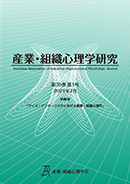Volume 35, Issue 1
Displaying 1-13 of 13 articles from this issue
- |<
- <
- 1
- >
- >|
-
2021Volume 35Issue 1 Pages 3-23
Published: 2021
Released on J-STAGE: December 29, 2022
Download PDF (1638K) -
2021Volume 35Issue 1 Pages 25-34
Published: 2021
Released on J-STAGE: December 29, 2022
Download PDF (1438K) -
2021Volume 35Issue 1 Pages 35-47
Published: 2021
Released on J-STAGE: December 29, 2022
Download PDF (1617K) -
2021Volume 35Issue 1 Pages 49-60
Published: 2021
Released on J-STAGE: December 29, 2022
Download PDF (2215K) -
2021Volume 35Issue 1 Pages 61-73
Published: 2021
Released on J-STAGE: December 29, 2022
Download PDF (1477K) -
2021Volume 35Issue 1 Pages 75-86
Published: 2021
Released on J-STAGE: December 29, 2022
Download PDF (1560K) -
2021Volume 35Issue 1 Pages 87-99
Published: 2021
Released on J-STAGE: December 29, 2022
Download PDF (1487K) -
2021Volume 35Issue 1 Pages 101-116
Published: 2021
Released on J-STAGE: December 29, 2022
Download PDF (2147K) -
2021Volume 35Issue 1 Pages 117-129
Published: 2021
Released on J-STAGE: December 29, 2022
Download PDF (1447K) -
2021Volume 35Issue 1 Pages 131-144
Published: 2021
Released on J-STAGE: December 29, 2022
Download PDF (1547K) -
2021Volume 35Issue 1 Pages 145-153
Published: 2021
Released on J-STAGE: January 20, 2023
Download PDF (1435K) -
2021Volume 35Issue 1 Pages 155-163
Published: 2021
Released on J-STAGE: December 29, 2022
Download PDF (1659K) -
2021Volume 35Issue 1 Pages 165-178
Published: 2021
Released on J-STAGE: December 29, 2022
Download PDF (1487K)
- |<
- <
- 1
- >
- >|
